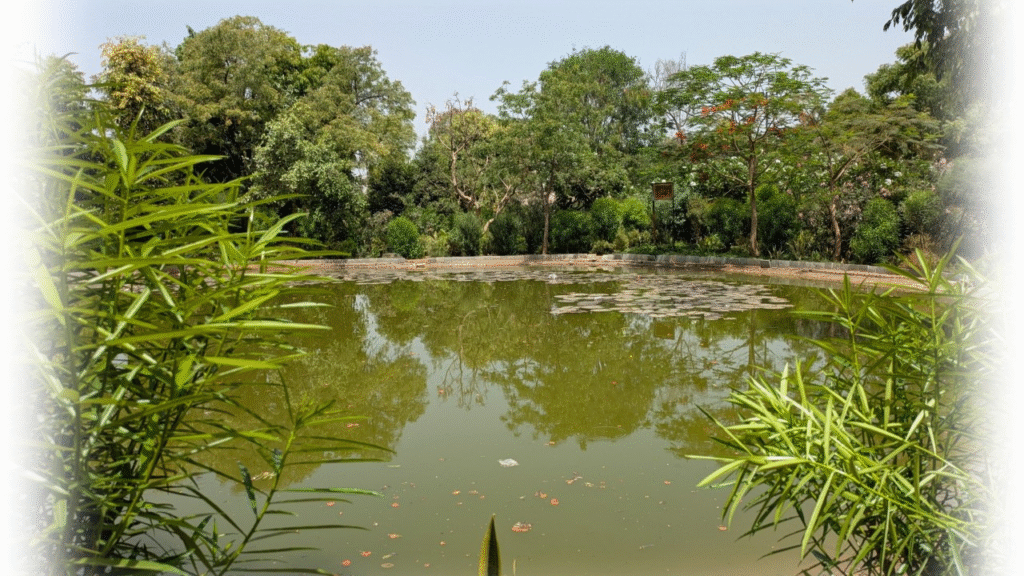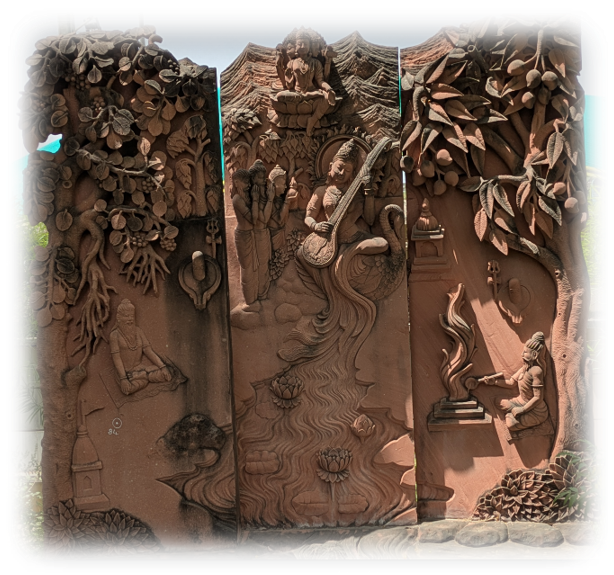
As I sat in front of my desktop on the sweltering Saturday afternoon of April 19, the wanderlust within me refused to sit still. Though I was in Ahmedabad for just a handful of days, the thought of a short road trip started shimmering like a mirage. Bindu Sarovar—one of India’s five holiest lakes had lingered in my mind ever since we passed it on our way to Sadakmaliya in Rajasthan a couple of months ago.
I rang up Prabhu and Ashok, our ever-reliable caretakers in Ahmedabad, and floated the idea. Since it was a Sunday and the destination held religious and spiritual significance, I suggested they check if their families would be interested in joining us. Their response was immediate and enthusiastic. By evening, our little travel party had come together: Ashok, Prabhu, their wives Sushila and Leela, and Ashok & Sushila’s two daughters—Riya, aged 15, and little Tanu, just 8. We agreed on an early departure—7:00 A.M.—to beat the worst of the summer sun and make the most of the day.
The next morning, Ahmedabad was still drowsy as we pulled out of the driveway. The streets lay quiet in the soft morning light, as we slipped out of the city. True to form, Sushila had packed breakfast for the road: perfectly spiced aloo parathas and soft methi theplas, wrapped in foil and still warm. The girls were full of excitement, pointing out sights and giggling in the backseat. At one point, I turned to Riya and asked her to look up Bindu Sarovar on her phone and tell us what she could find. With cheerful diligence, she read aloud snippets of its mythology and sacredness, turning the drive into a lesson in history, tradition, and faith.
Bindu Sarovar: Journey to the Basin of a Mighty River
Tucked away in the quiet town of Sidhpur, around 130 kilometers north of Ahmedabad, lies Bindu Sarovar—a revered site wrapped in deep spiritual significance. It is believed to rest on the ancient bed of the Saraswati River, a river once mighty and life-giving, now cloaked in mystery.
The Saraswati flowed from the heights of the Himalayas, coursing through the land with grace and power, nourishing northern and western India before merging with the Arabian Sea in the Gulf of Kachchh. Today, her presence is most profoundly felt not in sight, but in spirit, most notably at the Triveni Sangam in Prayagraj, the holy site which hosts Kumbha Mela—which is the sacred confluence of the three mighty rivers of India—the Ganga, the Yamuna, and the mythical Saraswati.
According to ancient lore and supported by geological studies, the Saraswati disappeared underground nearly 5,000 years ago due to massive tectonic shifts. What remained was a vast endorheic basin—which is a basin where water accumulates but does not flow out to the sea. The water is lost primarily through evaporation or by seeping underground. These basins are characterized by creation of saline lakes that may eventually dry up with changing climates.
The faith of millions however remains unshaken. Even now, many believe that the Saraswati never truly vanished—she simply disappeared and continues her journey silently beneath the earth’s surface. At places like Bindu Sarovar, one doesn’t just visit a site—one encounters a story, a presence—of a mighty river which though invisible still flows in spirit.
Bindu Sarovar: Where Faith Meets Eternity
Bindu Sarovar, the “lake of divine drops,” is not just a geographical landmark—it’s a timeless symbol of devotion, penance, and the eternal bond between mother and child. According to sacred lore, this hallowed lake was born of Lord Vishnu’s tears—tears of grace that fell upon the earth when he appeared before Sage Kardama who was son of Lord Brahma. After many years of unwavering tapasya (severe penance) on the banks of the holy Saraswati, the sage was blessed by Vishnu’s darshan, and in that moment of divine union, the drops that created Bindu Sarovar sanctified the land forever.
Among the five most sacred lakes in Hinduism—alongside Manas Sarovar in Tibet, Pushkar in Rajasthan, Narayana Sarovar in Gujarat, and Pampa Sarovar in Karnataka—Bindu Sarovar holds a place unlike any other. It is here that son of Sage Kardama, Sage Kapila, a revered seer of wisdom and liberation, taught his mother, Mata Devhuti the philosophy of Sankhya Yoga, and bestowed the sacred teachings of Moksha Gnana which led to her liberation from the eternal cycle of birth, death, and rebirth. Kapila’s action of love and devotion towards his mother consecrated Bindu Sarovar as a place of deep maternal reverence.
Legend also speaks of Lord Parshuram, the warrior sage and the sixth incarnation of Vishnu, who chose this sanctified spot to perform Matru Shraddha—the sacred rites for his beloved mother, Renukadevi. In a tradition steeped in emotion and dharma, Bindu Sarovar became the spiritual epicenter where the soul’s longing meets the mother’s eternal presence.
While Gaya in Bihar is revered across India for the performance of Pitru Shraddha—rituals for honoring fathers and ancestors—Bindu Sarovar holds a uniquely sacred space as the foremost site for Matru Shraddha, the ritual offerings made specifically for mothers and women. It is believed that the divine act of Lord Parshuram performing Shraddha for his mother here set a spiritual precedent, transforming the lake into a sanctum of maternal remembrance. Over generations, devotees have been drawn to this sacred site not only by tradition but by a deep, heartfelt desire to honor the nurturing spirit of the mother. Thus, Bindu Sarovar has come to be known as Matru Gaya—a place where the soul pays homage to the source of its earthly life, and where faith in the eternal bond between mother and child is enshrined in sacred ritual.
Our Visit to Bindu Sarovar – A Quiet Reflection
We reached the entrance gate of Bindu Sarovar by 9:30 A.M., greeted by the sight of a long line of vehicles—at least a hundred—parked along both sides of the road. The unexpected crowd meant parking nearly half a kilometre away and walking to the entrance on foot.
A prominent board near the gate announced that photography was strictly prohibited. Respecting the instruction, we followed a wide pathway paved with pink stones. To our right, a garden lent a touch of green as we approached a cluster of buildings that appeared to form the heart of the site.
Before long, we found ourselves at a small square pond, approximately 1000 square feet in size, bordered by stone steps. Visitors were required to descend barefoot and cleanse their feet in the pond’s water before entering the nearby temples. A few were also taking a ritual dip. Upon inquiring with the security staff, we learned that this modest pond was indeed the sacred Bindu Sarovar.
The temples encircling the pond—constructed in light pink Jodhpur sandstone—were dedicated to revered figures such as Sage Kapila, Sage Kardama, Lord Parshuram, Mata Devahuti, Goddess Parvati, Lord Shiva, and Lord Vishnu in the form of Gaya Gadhadhara. While Prabhu and I chose to remain by the pond, the rest of our group visited a few of the shrines.
Beyond the temple cluster lay a spacious open area scattered with small chhatris—pavilion-like structures, each capable of seating eight to ten people. Most were occupied by priests and families engaged in performing shraddha ceremonies. Even the large hall intended for visitor rest had been repurposed to accommodate the overflow of families participating in these rituals. The buildings were interspersed with tall neem and peepal tress that provided much needed shade against the summer sun.
The visit left us with mixed feelings. The spiritual significance of Bindu Sarovar—rooted in deep tradition and reverence—remains undiminished. Yet, the physical scale and visibly artificial nature of the pond, along with the paved courtyards and neatly constructed complex, felt unexpectedly anticlimactic compared to the imagery its name and renown had evoked.
Whispers of a Forgotten Bindu Sarovar
As we made our way back toward the entrance, a quiet impulse drew us toward the garden we had passed earlier. At the time, it felt like a casual decision—an afterthought. But in truth, it turned out to be the soul of our visit.
The garden, spread across nearly two acres, stood silent and unoccupied. With most visitors drawn to the temple complex, we found ourselves alone amid its winding paths, shaded by tall trees and bordered by flowering shrubs. The quiet hum of bees circling hidden hives, the rustling leaves, and the occasional birdsong wove a tapestry of sound that felt ancient and unspoiled. It was as if we had stepped back into a time when nature, not stone, shaped the sacredness of this place.
Wandering deeper, we stumbled upon a natural pond, roughly 200 feet across, it’s still waters lightly adorned with blooming water lilies. Grassy banks and wild shrubs embraced the water, unmanicured and quietly alive. Sitting at the edge of the pond, a profound stillness enveloped us, and in that moment, the centuries seemed to melt away. It was easy to imagine that this — not the paved courtyards or pink-stone shrines — was how Bindu Sarovar must have once appeared: a vast, living expanse of sacred water held gently by the earth, sky, and forest.
As we reluctantly rose to leave, another quiet discovery awaited us. Along a winding path back to the entrance, set against a backdrop of greenery, stood a beautiful sculpture carved from stone, almost eight feet tall and ten feet across. The sculpture, composed of three flowing panels, seemed to tell the very story of Bindu Sarovar itself.

On the left, a serene sage sat in deep meditation beneath a sacred tree, evoking an era when wisdom grew together with the forests. The central panel depicted Goddess Saraswati, her veena flowing seamlessly into streams of water, as if to remind us that knowledge, music, and rivers spring from the same divine source. To the right, a figure performed a yajna (ritual offering) by a sacred fire, symbolizing the human longing to honour and connect with forces greater than themselves.
The sculpture, weathered yet dignified, stood not as an embellishment but as a living testament—a reminder that the true sanctity of Bindu Sarovar was once intertwined with nature, spirit, and an unhurried reverence for life.
We left the garden slowly, carrying within us not just the memory of a tranquil walk, but the bittersweet echo of a deeper loss. And yet, there was solace too. In the untouched corners of the earth, where water lilies bloom without witness and the trees still hum with hidden songs, the sacred survives—patient, waiting for those who still know how to listen to its silence.
#BinduSarovar #Sidhpur #SageKardama #SageKapila #Parshuram #MatruShraddha #MatruGaya #SaraswatiRiver #Shraddha
